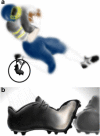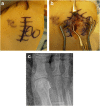Injuries to the great toe
- PMID: 28124292
- PMCID: PMC5344861
- DOI: 10.1007/s12178-017-9390-y
Injuries to the great toe
Abstract
Purpose of review: Injuries to the great toe are common in athletes. While most are managed nonoperatively and allow return to sports activity, some great toe injuries are highly problematic and can impact function. The purpose of this review is to highlight several specific injuries and disease processes involving the hallux and to detail current recommendations and management options in order to help raise suspicion for injuries that can result in long-term dysfunction.
Recent findings: Toe injuries have been found to represent nearly 10% of injuries presenting to fracture clinics. While most injuries can be treated nonsurgically, there are a number of specific injuries that require a high index of suspicion, careful management, and in some cases, surgical intervention. Injuries detailed in this review include turf toe, traumatic bunion, and hallux and sesamoid fractures. Additional pathologies that are covered include sesamoiditis and sesamoid avascular necrosis as well as hallux rigidus. Appropriate workup and current treatment recommendations are discussed. Injuries to the hallux can result in long-term pain and disability if not properly diagnosed and treated. A high index of suspicion is required.
Keywords: Fracture; Hallux injury; Sesamoids; Traumatic bunion; Turf toe.
Conflict of interest statement
Conflict of interest
Philip J York and Frank B Wydra declare that they have no conflict of interest.
Kenneth J Hunt reports grants from Acumed and ISAKOS outside of the submitted work.
Human and animal rights and informed consent
This article does not contain any studies with human or animal subjects performed by any of the authors.
Figures








Similar articles
-
Diagnosis and conservative management of great toe pathologies: a review.Postgrad Med. 2021 May;133(4):409-420. doi: 10.1080/00325481.2021.1895587. Epub 2021 Apr 4. Postgrad Med. 2021. PMID: 33622169 Review.
-
Plantar-plate disruptions: "the severe turf-toe injury." three cases in contact athletes.J Athl Train. 2015 May;50(5):553-60. doi: 10.4085/1062-6050-49.6.05. Epub 2015 Feb 19. J Athl Train. 2015. PMID: 25695855 Free PMC article.
-
The great toe: failed turf toe, chronic turf toe, and complicated sesamoid injuries.Foot Ankle Clin. 2009 Jun;14(2):135-50. doi: 10.1016/j.fcl.2009.01.001. Foot Ankle Clin. 2009. PMID: 19501799 Review.
-
Hallux sesamoid complex imaging: a practical diagnostic approach.Skeletal Radiol. 2020 Dec;49(12):1889-1901. doi: 10.1007/s00256-020-03507-8. Epub 2020 Jun 24. Skeletal Radiol. 2020. PMID: 32583133 Review.
-
Incidence and risk factors for turf toe injuries in intercollegiate football: data from the national collegiate athletic association injury surveillance system.Foot Ankle Int. 2014 Feb;35(2):108-15. doi: 10.1177/1071100713514038. Epub 2013 Dec 11. Foot Ankle Int. 2014. PMID: 24334272
Cited by
-
Comparative study assessing sporting ability after Arthrodesis and Cartiva hemiarthroplasty for treatment of hallux rigidus.J Orthop. 2019 Sep 23;18:50-52. doi: 10.1016/j.jor.2019.09.023. eCollection 2020 Mar-Apr. J Orthop. 2019. PMID: 32189883 Free PMC article. No abstract available.
-
Facial Plates in Phalanx Fracture-Non-Union of Great Toe - A Case Report.J Orthop Case Rep. 2023 Feb;13(2):21-24. doi: 10.13107/jocr.2023.v13.i02.3540. J Orthop Case Rep. 2023. PMID: 37144070 Free PMC article.
-
An overlooked cause of forefoot pain in athletes: Avascular necrosis of the lateral hallucial sesamoid.Radiol Case Rep. 2025 Jun 21;20(9):4522-4525. doi: 10.1016/j.radcr.2025.05.105. eCollection 2025 Sep. Radiol Case Rep. 2025. PMID: 40612971 Free PMC article.
-
Forefoot Injuries in Athletes: Integration of the Movement System.Int J Sports Phys Ther. 2022 Jan 1;17(1):81-89. doi: 10.26603/001c.30021. eCollection 2022. Int J Sports Phys Ther. 2022. PMID: 35024208 Free PMC article.
-
High-Resolution MRI of the First Metatarsophalangeal Joint: Gross Anatomy and Injury Characterization.Radiographics. 2020 Jul-Aug;40(4):1107-1124. doi: 10.1148/rg.2020190145. Epub 2020 May 15. Radiographics. 2020. PMID: 32412828 Free PMC article. Review.
References
Publication types
LinkOut - more resources
Full Text Sources
Other Literature Sources
Research Materials

